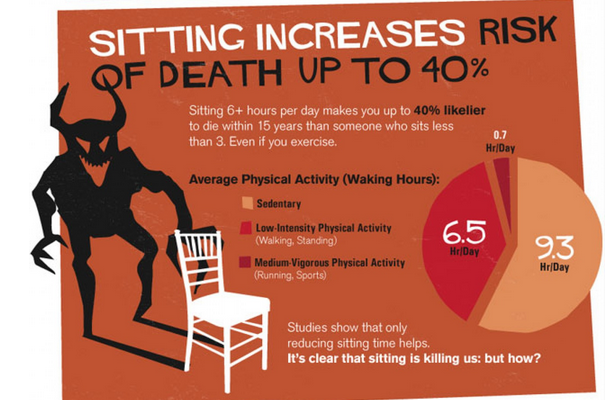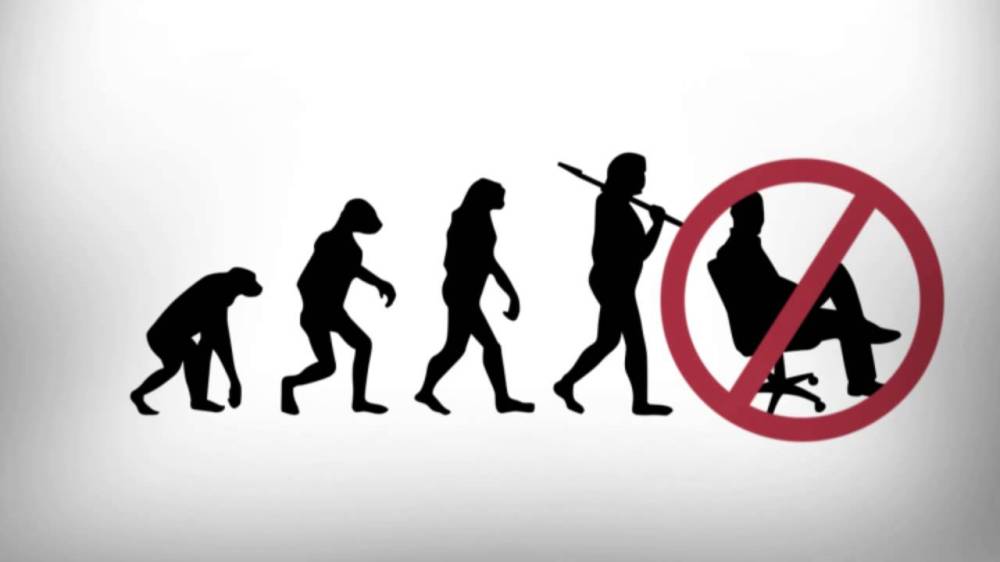
11 Insights to Manage Post Pregnancy Hair Loss
May 9, 2018
And you thought only women PMS…
May 9, 2018You are not born with a fixed amount of resilience.
It’s a muscle, you can build it up, and then draw on it when you need it.”
How many hours do you spend sitting on an average workday? Our recent sedentary modern work lifestyle has now become the newest addition to the health challenges being faced by overworked executives around the globe.
Prolonged periods spent on your office chair are directly linked to obesity and are also the triggers to a staggering list of other medical conditions. These include diabetes, heart and coronary, depression and motor neuron challenges.
 Experts now identify SITTING as ‘the new smoking’, a time bomb waiting to explode. The World Health Organisation has already identified physical inactivity as the fourth biggest killer on the planet, ahead of obesity.
Experts now identify SITTING as ‘the new smoking’, a time bomb waiting to explode. The World Health Organisation has already identified physical inactivity as the fourth biggest killer on the planet, ahead of obesity.
Studies in human behavior on physical activity reveal that on an average we spend a staggering 8.9 hours every day sitting down. This may happen while we are at work, in a car or at home on the sofa watching our favorite TV shows. Add another seven hours sleeping and that means most spend just one third of their time on their feet.
Many organizations already aware of the health hazard ahead have started campaigns which aim to get their employees back on their feet. Some have gone further ahead and completely removed chairs from their offices in order to keep the health of individual employees in check.
Its no secret that sedentary lifestyle is bad and unhealthy for us all like smoking or any other addictive habit. Spending less time sitting can add healthy years to our life. However its very unfortunate that for many people the idea seems hard to believe.
WHO guidelines on Exercise
Recent recommendations on healthy exercising by World Health Organisation recommends that an adult should do at least 150 minutes of moderate exercise a week, — 30 minutes on at least five days. Recommendations reveal though this would be enough to gain the main benefits of regular exercise, however, it won’t protect you from the dangers of a sedentary lifestyle if you spend too much time sitting.
Dr John Buckley, an expert in exercise science at Chester University, says: “some benefits 30 minutes’ of cycling exercise may be lost if you spend your whole day just sitting. It is like exercising but then eating an junk food or exercising but not quitting to smoke. Physical inactivity is equally as important as those other well-known issues like diet and smoking.”
Why inactivity is dangerous
Our metabolism severely drops if we sit for long hours. It also disrupts the way the enzyme lipoprotein lipase breaks down our fat reserves. Blood glucose levels and blood pressure both increase in rest state thereby adding to the body woes.
Small amounts of regular activity, even just standing and moving around, throughout the day is enough to bring the increased levels back down. And those small amounts of activity add up — scientists have suggested that 30 minutes of light activity in two or three-minute bursts could be just as effective as a half-hour block of exercise.
But without that activity, blood sugar levels and blood pressure keep creeping up, steadily damaging the inside of the arteries and raising the risk of diabetes, heart disease and stroke.
Engaging people in physical activity in-order to bring down their sitting time can be a single biggest step towards cutting the of developing deadly lifestyle based diseases.
Let us all understand very loudly and clearly that ,” the human race didn’t evolve to spend so much time sitting down,” says an expert. “Up until relatively recently, we spent much of our time moving around.”
Dangers of Sitting
Way back in 1950’s a study conducted on of bus drivers and conductors by Transport for London in the provided stark evidence of the dangers of spending too much time sitting down. It found that drivers, who spend more of their time sitting, were 1.5 times as likely to develop heart disease as conductors, who stood more often.
Getting people on their feet can prevent and alleviate back problems, which are commonly caused by spending too much time sitting or sitting with poor posture.
Stand and Work
The benefits of standing at work are gradually starting to catch on. Just last month, Victoria Beckham was photographed walking while working after swapping her office chair for a treadmill desk.
Such luxuries are not for everyone. Adjustable sit-stand desks that allow workers to alter the height and work while sitting down or standing up offer a more practical solution.
Interestingly, standing desks are much common in Scandinavia, where staff have the right to work standing up. In this country, they are usually seen as treatment tools for patients who already suffer from back problems, rather than a way to prevent issues in later life.
 We should make a change now
We should make a change now
The benefits of standing apply across all age groups and parents could help their children by limiting the time infants spend restrained in buggies and car seats. The need for exercise remains crucial in later life and the elderly can help keep their bones and muscles strong by standing up and moving around regularly.
– Electrical activity in the leg muscles shuts off
– Calorie burning drops to 1 per minute
– Enzymes that help break down fat drop by 90%
– Good cholesterol drops by 20%
After 24 hours:
– Insulin effectiveness drops by 24% and risk of diabetes rises
– Muscle activity drops severely resulting in less blood flow and muscle cramp like conditions.

About the Author
Dr. Amitabh Singh is the founder of AadyantaLife and Bio-Energetic & Crystal Healer and Wellness Coach. He provides Alternative and Complementary Healing therapies to difficult ailments including Cancer. He specializes in Mindfulness Meditation Coaching for Corporate and Business Leaders. His thought-provoking Enlightening Lectures





